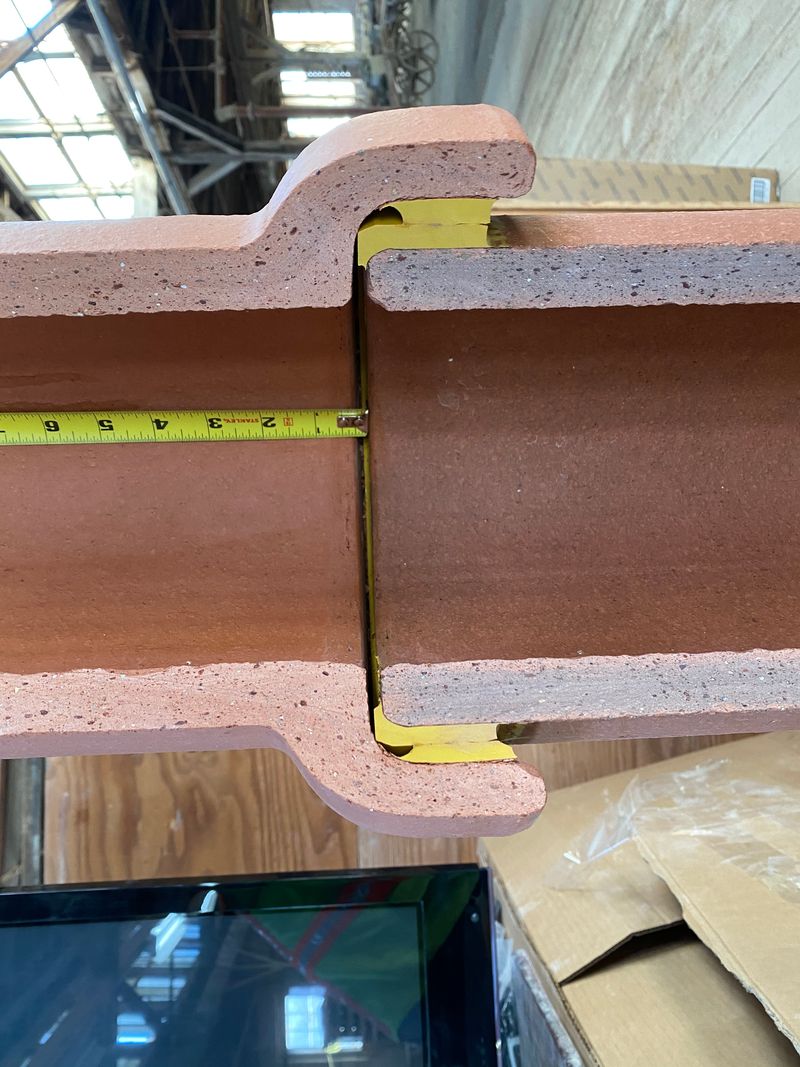Do Clay Pipe Joints leak?
Modern VCP joints do not leak. Clay Pipe manufactured in the U.S. since the 1950s has durable, factory-applied flexible compression joints and couplings that effectively eliminate water leakage while providing the needed flexibility. Misinformation about leaking joints is attributed to the long service life of clay pipe installations of well over a century in service. Clay pipe installations over 70-years old may have field-manufactured joints that may not meet current standards. All factory-applied clay pipe jointing systems, whether on bell-and-spigot pipe, plain-end pipe, or jacking pipe are designed to provide resilience and flexibility to accommodate minor pipe movement while maintaining a strong, leak-free joint.
All compression type jointing methods for VCP meet the prerequisite of ASTM C425, which requires that the joints not leak when subjected to both shear load and deflection. With proper installation, a clay pipe sewer system can meet or exceed standards for infiltration or exfiltration.
What are the deep installation techniques available for VCP?
NCPI has completed many research projects resulting in methods of installation for VCP in deep applications. Our research, specifically on CLSM (Controlled Low Strength Material) is a solution for structurally supporting open trench VCP in deep installations.
Trenchless installation is also an option for deep burial VCP. Vitrified Clay Jacking Pipe can be installed by either using pilot tube or slurry microtunneling methods.
What is the tensile strength of a VCP joint?
The minimum shear loads on assembled VCP joints are specified in ASTM C425 and ASTM C1208 (for jacking pipe). These loads are variable based on pipe diameters and far-exceed the permissible shear loads of most competitive products.
What’s the difference between VCP and Terra Cotta?
Terra cotta is a non-technical term that can be used to describe a color, a type of wall cladding, pots and other ceramic products that can vary greatly in strength and composition, but are generally manufactured to have a high porosity. Terra cotta, when describing a pipe refers to a material fired to approximately 1200°F. Vitrified Clay Pipe is fired to over 2000°F to fuse the molecules resulting in a ceramic with high strength and low porosity.
How does VCP perform in seismic events?
VCP holds up very well in seismic zones. The short lengths (as compared with other materials) and flexible compression joints can take both angular deflection and shear forces to endure the lateral waves. VCP sections do not deflect or deform with loading changes. The clay pipe manufacturers have been industry leaders in the development of seismic cushions within the joints. Even before the introduction of the seismic cushion, in the few zones that have been studied following an earthquake, VCP lines were statistically the most likely to have survived a 7.1 quake.
The factory-applied flexible joint can take angular deflection and a tremendous amount of shear loading which are key elements in pipeline seismic resiliency.
Optimal Mix for CLSM?
NCPI conducted extensive research into the optimal mix design for CLSM. The research prioritized quick setting for same day backfill while maintaining the desired strength. See the complete research paper, including the optimal mix here.
How does load transfer to the pipe when CLSM bedding is used?
The backfill load is distributed uniformly across the top of the pipe and the CLSM sidefills. As compared to granular bedding, CLSM bedding carries a significant share of the trench backfill load.
How has the strength of clay pipe changed over the last 100-years?
 In 1913, when ASTM published the first bearing standard, a 12” diameter pipe (standard strength) was only required to bear 1,200 lbs/LF. As research into Factors of Safety and Bedding Classes evolved, so did clay pipe. Today a 12” diameter, (extra strength) pipe must bear 2,600 lbs/LF.
In 1913, when ASTM published the first bearing standard, a 12” diameter pipe (standard strength) was only required to bear 1,200 lbs/LF. As research into Factors of Safety and Bedding Classes evolved, so did clay pipe. Today a 12” diameter, (extra strength) pipe must bear 2,600 lbs/LF.
When would I use the Modified Marston equation to determine the backfill load on the pipe?

The Modified Marston design approach would be applicable when the CLSM bedding class is used. CLSM is placed from the bottom of the barrel to the top of the barrel and the width of the trench.
When did flexible compression joints become the standard in the US?
Factory applied flexible compression joints were developed in response to the desire in the water treatment industry to install water tight systems. In 1958, NCPI began to develop leak-free joint systems for our manufacturers. It took many years to implement across the industry. It is believed that all U.S. manufacturers were using the factory applied, leak-free, flexible compression joint by 1970 when the clean water act made “leak-free” the standard.
How is the clay pipe industry considered “innovative?”
For over a century, since the inception of standards for manufacturing and installing pipelines, clay pipe manufacturers have led the way. Some of the high points include:
- The first ASTM Committee established for standard specifications and tests in the sewer pipe industry
- The first Memoranda of Recommendations for the Laying of Sewer Pipe was led by Anston Marston as part of ASTM Committee C04
- The first bell & spigot joint (even before joints were factory-applied)
- Led development of the compression joint in the 50s
- Developed the Low-Pressure Air Test for acceptance testing in the 70s
- Conducted extensive testing on CLSM as a bedding material leading to the Optimal Mix Design published in 2010.

For complete technical information, download our Manual or one of our Handbooks.
*Qualifies for PDH Credits



